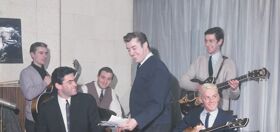 It seems that power training is all the rage these days. Explosive, high power, compound movements and plyometrics are rapidly making their way into programming and “boxes” throughout the fitness industry. Power training is the pinnacle of any professional athlete’s training program. Nowadays, many individuals are striving for the aesthetic of a long, lean, and defined athletic body – a physique that is not only visually appealing, but functionally fit. The mindset today seems to be “if you want to look like an athlete, you have to train like an athlete.” As trends like this become mainstream, let’s consider: is power training for everyone? Should everyone be training like an athlete?
It seems that power training is all the rage these days. Explosive, high power, compound movements and plyometrics are rapidly making their way into programming and “boxes” throughout the fitness industry. Power training is the pinnacle of any professional athlete’s training program. Nowadays, many individuals are striving for the aesthetic of a long, lean, and defined athletic body – a physique that is not only visually appealing, but functionally fit. The mindset today seems to be “if you want to look like an athlete, you have to train like an athlete.” As trends like this become mainstream, let’s consider: is power training for everyone? Should everyone be training like an athlete?
Power training is nothing new to the world of fitness. Over the last decade, there has been an exodus of people returning to classic movements and exercises, such as kettlebells, Olympic lifts, and plyometrics, which require minimal equipment but are highly effective training tools. Programs such as high-intensity interval training (HIIT) are simple, utilize minimal equipment, are highly effective, and require much less time to perform than standard isolation and hypertrophy workouts. However, power training requires a comprehensive knowledge base and some basic fundamentals before exercises can be executed safely and correctly. My mantra is this: stop training like an athlete to get into shape, and start getting into shape to train like an athlete!
To better understand power training, think of some of the physics principles you might have learned in high school. In terms of “power training,” power is pushing mass (weight) for a specific distance in a short amount of time. Power training is explosive but controlled. It is also the most challenging form of training, reserved for athletes who have mastered basic stability, balance and strength. Anyone whose goal is power training should use periodization methods to prepare for a physically and mentally demanding experience. Without proper conditioning, power training can result in injuries and various muscular and skeletal dysfunctions. At best, you’ll be doing a whole lot of ineffective training.
Before any training program, you should get assessed for common structural dysfunctions that develop from sitting at a desk, crouching over a phone, etc. A postural assessment allows a trainer to program corrective exercises for any muscular imbalances that will affect your movement patterns. A brief discussion of medical history will disclose any previous injuries or surgeries, and a movement analysis (such as an overhead squat assessmen)t will bring an awareness to any compensation patterns that may need to be addressed as well.
How about we take this to the next level?
Our newsletter is like a refreshing cocktail (or mocktail) of LGBTQ+ entertainment and pop culture, served up with a side of eye-candy.
One big imbalance that many people struggle with is stability. Stability training is the foundation for all human movement. We balance all day long without even thinking about it. During a normal human walking cycle, more than half of the time we are balancing on a single foot. Training the body to become more stable allows us to control and accommodate larger loads (weight). Having proper core stability allows us to handle the forces of gravity and external loads without injury or pain. Training and developing stabilizers in major muscles and their helpers allows them to fire off in the correct movement patterns, producing movement without injury or compensation.
A perfect example where stability training would improve performance in a power move is an Olympic barbell snatch. Once you have “snatched” the barbell over your head and into an overhead squat position, the stabilizers in your core, shoulders, legs, triceps and calves all kick in and allow you to secure the weight over your head safely. Otherwise, you risk of losing your balance, dropping the weight, or compensating with incorrect muscles and injuring yourself. Stability training is generally the first phase of training with athletes to increase the intensity of workouts by proprioceptively enriching the exercises versus just “adding more weight.”
 After stability and balance come strength-based training, and hypertrophy training (increasing muscle cell size). There is an often-incorrect assumption that strength and size are the same and can be trained in the same manner. When someone is interested in adding mass to their body in the form of hypertrophy, the programming is quite different from a strength based program, as pushing HEAVY weight will get you strong, but it won’t necessarily get you bigger. Most athletes who want to add size typically only train in hypertrophy-based programs and neglect any other aspects of training. Taking an athlete through periods of strength-based training increases their strength, thus increasing their potential 1-rep max’s and increasing the load that they can carry during hypertrophy training. The result will be increased gains in hypertrophy. It is also important to note that periodically returning to a stability-based program reduces joint stress that can be a result of intense strength and hypertrophy training.
After stability and balance come strength-based training, and hypertrophy training (increasing muscle cell size). There is an often-incorrect assumption that strength and size are the same and can be trained in the same manner. When someone is interested in adding mass to their body in the form of hypertrophy, the programming is quite different from a strength based program, as pushing HEAVY weight will get you strong, but it won’t necessarily get you bigger. Most athletes who want to add size typically only train in hypertrophy-based programs and neglect any other aspects of training. Taking an athlete through periods of strength-based training increases their strength, thus increasing their potential 1-rep max’s and increasing the load that they can carry during hypertrophy training. The result will be increased gains in hypertrophy. It is also important to note that periodically returning to a stability-based program reduces joint stress that can be a result of intense strength and hypertrophy training.
Now we have finally made it to the pinnacle of athleticism – the level where everyone seems to want to train — POWER. You want to create a maximal amount of force in a minimal amount of time. To be executed safely, power must be controlled using our new friends; stabilization, balance, and strength. Power moves encompass the whole body, use compound movements, and require a much greater neuromuscular effort from your body versus other levels of training.
To put it mildly, power training is intense and can be incredibly dangerous if not done properly. An injury can come at a high cost and can set an athlete back months in a training program. Power exercises are best suited in the beginning of a workout, after a proper warmup that includes mobility and dynamic moves. Dynamic stretching with specific attention to the exercise selection is crucial before proceeding to power exercises. It is also important to note that power exercises, while explosive, train the body to handle the forces of acceleration. However, training the body to handle the forces that occur during deceleration, especially in plyometrics, is essential to injury prevention. Improper form or kinetic chain dysfunction can cause joint pain or long-term injury. Exercises like Olympic lifts (barbell snatch, barbell clean and jerk), kettlebells, box jumps, squat jumps, explosive push-ups, wall balls, and any other exercises that involve propelling weight quickly and explosively should be coached by a trained professional with an eye for proper form and cueing. These moves require essential fundamental skills that the average weekend warrior or gym goer simply does not possess without prior instruction. Power moves can be mastered, but can take months, if not years, to safely and effectively execute them to a level where they can be programmed into a regular workout routine.
The old adage from the ’80s of “no pain, no gain” seems to be creeping back into the mindset of many enthusiastic gym goers and group fitness instructors these days. The “go big or go home” mentality that is the mantra of many fitness professionals can be doing more harm than good to clients and athletes. The truth is, every workout doesn’t have to leave you unable to get off the floor and feeling like you need to vomit. Training with such intensity on a regular basis is unnecessary and unwarranted for the average person looking to live a healthy lifestyle and get into shape. The fitness industry is notorious for setting new trends on a regular basis. Just because something is trending doesn’t mean that it is meant for anyone and everyone. Remember, don’t train yourself like an athlete to get into shape, get into shape to train like an athlete!
For more information or to book a class, visit www.phoenixeffectla.com.
The Phoenix Effect, a functional group fitness studio that gets you in shape fast, is offered exclusively at 7264 Melrose Ave., Los Angeles, CA.

















